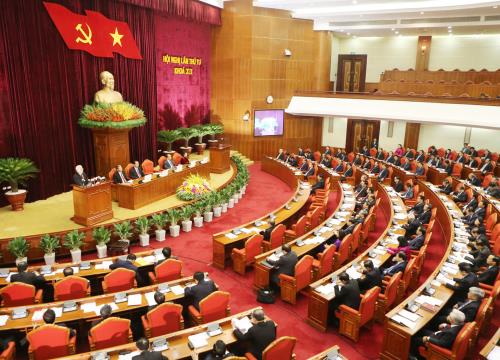Economic development and FTAs on Party plenum agenda
- Nation must improve economic competitiveness: think-tank
- Head of the Central Economic Committee visits and works in Ninh Thuan Province
- Party Central Committee opens fourth plenum
On the first day of the 4th plenum on October 9, the CPV also noted signs of “self-evolution” and “self-transformation” within the party.
High on the agenda for the week-long plenum are discussions among the 12th Party Central Committee, chaired by Party General Secretary Nguyen Phu Trong, on the socioeconomic situation in 2016 and plans for 2017, according to the Vietnam News Agency.
 |
| At the event. (Photo: VNA) |
The plenum will also give its opinion on several major policies renewing the growth model and increasing growth quality, productivity, and the economy’s competitiveness as well as how to effectively carry out international integration while maintaining political stability in the context of Vietnam signing next-generation free trade agreements.
In early October the Vietnam-Eurasian Economic Union Free Trade Agreement (VN-EAEU FTA) came into effect, which covers matters pertaining to trade, services, investment and the movement of citizens. Annual bilateral trade may increase from the current $4 billion to $8-10 billion under the agreement. Tariffs on imports from the Union will be cut by about $40 million in the first year, according to the Eurasian Economic Commission.
Vietnam is now able to enter a large market of great potential, with total GDP of some $2.2 trillion and 183 million consumers while products from the EAEU will have access to Vietnam’s 90 million people.
Vietnam will immediately remove import tariffs on 59 per cent of goods from the EAEU, including meat, flour, alcohol, mechanical equipment and steel products. Tariffs on another 30 per cent of goods will be gradually reduced to 0 per cent during the transitional period.
The TPP, which Vietnam signed early this year, will not be on the agenda of the National Assembly (NA) sessions this year.
Vietnam’s economy has continued to exhibit signs of recovery and stable growth in the last three quarters, with GDP growing at an estimated 5.93 per cent, according to the NA’s Economic Committee.
Macroeconomic indicators have been stable and inflation controlled, according to a government report on the implementation of the 2016 socioeconomic development plan presented at the meeting.
Annual inflation is forecast at below the 5 per cent target set by the NA. A report from the Ministry of Planning and Investment (MPI) released in early October acknowledged that the GDP target of 6.7 per cent is unlikely to be met due to the impacts of natural disasters on the agriculture sector.
Vietnam’s 2016 GDP growth will come in at 6.1 per cent and 6.2 per cent in 2017 while growth in ASEAN-5 is expected to remain stable in 2016 before rising modestly in 2017, according to the International Monetary Fund (IMF)’s Regional Economic Outlook (REO) Update released on October 5.
The update revised Vietnam’s growth in 2016 down 0.2 per cent compared to IMF’s forecast in April. Vietnam’s current account balance is expected to narrow to 0.4 per cent in 2016 and 0.1 per cent in 2017.
While the near-term outlook is broadly positive, IMF analysts noted that there are downside risks, including from high and rising public debt, slow non-performing loan resolution, prolonged drought, tighter or more volatile global financial conditions, and weak growth in key advanced and emerging economies.
The CPV plenum will close on October 15.

